Oct 6, 2010 | counterfeit, currency
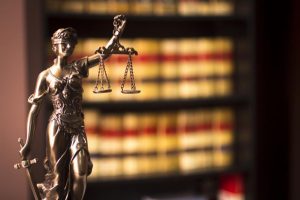 We start our look at the police blotter by reporting that FBI officials in New York reported that they arrested a Manhattan-based jeweler for allegedly robbing noted dealer Julian Leidman. Leidman estimated that 90-percent of his inventory has been recovered of an estimated $1 million worth of coins. Leidman’s car was broken into while he stopped at a restaurant in Montville, NJ on the way home from a show in Stamford, Connecticut.
We start our look at the police blotter by reporting that FBI officials in New York reported that they arrested a Manhattan-based jeweler for allegedly robbing noted dealer Julian Leidman. Leidman estimated that 90-percent of his inventory has been recovered of an estimated $1 million worth of coins. Leidman’s car was broken into while he stopped at a restaurant in Montville, NJ on the way home from a show in Stamford, Connecticut.
ELKHART, Indiana—Police are warning business that someone is passing counterfeit $100 notes. All notes are using the same serial number (HE88210403B) and appear realistic. What is worrying police is that the bills are not responding to counterfeit detection pens, suggesting the notes were probably printed on bleached lower denomination notes. Police are suggesting that merchants check “100” in the lower right hand corner for color shifting ink. It is being reported that the same notes are showing up across the border in Dowagiac, Michigan.
DANBURY, Connecticut—Police arrested two Brooklyn, NY men for passing $700 worth of $100 notes at Danbury Fair Mall on Sunday. A third suspect allegedly got away. The men attempted to pass these notes for small purchases, usually less than $10, but raise the suspicion of a clerk who called the police. When arrested, one of the men was in possession of two counterfeit $100 notes and marijuana. Another was arrest with more counterfeit notes while trying to shoplift at another store. Both men are being held on $45,000 bonds.
ALLEN PARK, Michigan—According to a criminal complaint filed in the United States Attorney for the Eastern District of Michigan, a man was arrested for counterfeiting $100 notes in a local hotel room. The alleged perpetrator was buying household chemicals at a local store and using them to bleach $5 notes. The notes were then printed using a printer in the room. When the police arrested the man they found 49 counterfeit $100 notes and eight bleach $5 notes. The man arrested said that he was going to use the money to buy large amounts of marijuana for resale.
SALISBURY, Maryland—A Virginia woman is in custody for passing counterfeit notes to several Salisbury businesses. Janet Perrin, 27, was extradited from Fairfax, VA on a warrant charging her with three counts each of possession of counterfeit money and manufacturing counterfeit money. It has been alleged that Perrin passed more than 10 counterfeit $100 notes.
Also in Salisbury, Maryland, it was reported that Shawn L. Brown, 35, was arrested and charged with counterfeiting currency and indecent exposure on September 20 by Maryland State Police. No further information has been published.
Jun 28, 2010 | BEP, counterfeit, currency, legal
When the British first founded colonies in North America, currency was limited to coins whose value was based on their metal content. When the King taxed his colonies to pay for wars in Europe, the colonies looked for ways of financing their own governments to provide services.
Since it was illegal for the colonies to coin money, they issued paper notes. These notes functioned as currency but actually were bills of credit, short-term public loans to the government. For the first time, the money had no intrinsic value but was valued at the rate issued by the government of the colony in payment of debt. Every time the colonial government needed money to pay creditors, they authorized the printing of a specified quantity and denomination of notes. Laws authorizing the issuance of notes were called emissions. The emission laws also included a tax that was used to repay the bills of credit with interest.
As taxes were paid using the paper currency, the paper was retired. As the notes were removed from circulation, that meant less payments the government had to make. On the maturity date, people brought their notes to authorized agents who paid off the loan. Agents then turned the notes over to the colonial government for reimbursement plus a com- mission. Sometimes, colonies could not pay back the loan. They instead passed another emission law to cover the debt owed from the previous emission plus further operating expenses, buying back mature notes with new notes. The colonists accepted this system since it was easier than barter and there were never enough coins to meet commercial needs.
Counterfeiting was rampant by the mid-18th century. In order to combat the problem, Benjamin Franklin devised the nature print, an imprint of a leaf or other natural item with its unpredictable patterns, fine lines, and complex details made it more difficult to copy.
To create a nature print, Franklin placed a leaf on a damp cloth. The cloth was placed on top of a bed of soft plaster that pressed the leaf into the plaster. Once the plaster hardened, it had a negative impression of the leaf. Molten copper was then poured over the plaster to make the printing plate. Franklin first used nature prints for the 1737 New Jersey emission. He also used different leaves for different denominations and elaborately engraved borders to further thwart the efforts of potential counterfeiters.
Franklin partnered with David Hall printing notes for New Jersey and Pennsylvania colonies. Along with his nature print, Franklin also included the phrase “Tis Death to Counterfeit.” Aside from trying to scare away potential counterfeiters, the penalty for counterfeiting in the 18th century was death. No convictions for counterfeiting colonial currency or death sentences have been recorded.
Later, Hall partnered with William Sellers to print Pennsylvania currency when Franklin was sent to England by the Pennsylvania assembly as their colonial agent.
Other printers tried different methods to thwart counterfeiters. James Parker of Woodbridge, New Jersey printed notes in two colors. With printing a labor intensive process, it was thought the process to cumbersome for counterfeiters to go through the process of the second printing. Also, Parker used red ink as the second color. Red was more expensive than black ink in the 18th century.
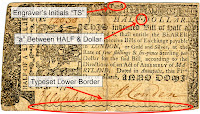 In Maryland, William Green of Annapolis used other anti-counterfeiting measures included using random wavy (indented) borders that had to match the original stub book, elaborate engravings, random punctuation, and superfluous characters. The example to the right is a “Half of a Dollar” from the Maryland emission of March 1, 1770. On this example, the engraver’s initials “TS” (Thomas Sparrow) appear at to the top, a small “a” was inserted between “half” and “dollar” while there is an accent mark over the “a” in “Exchange.”
In Maryland, William Green of Annapolis used other anti-counterfeiting measures included using random wavy (indented) borders that had to match the original stub book, elaborate engravings, random punctuation, and superfluous characters. The example to the right is a “Half of a Dollar” from the Maryland emission of March 1, 1770. On this example, the engraver’s initials “TS” (Thomas Sparrow) appear at to the top, a small “a” was inserted between “half” and “dollar” while there is an accent mark over the “a” in “Exchange.”
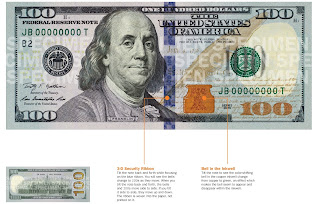 Anti-counterfeiting technology has become very advanced since the colonial days. When the Bureau of Engraving and Printing introduced the new $100 Federal Reserve Note, its anti-counterfeiting technology included a watermark, a security thread, color-shifting ink, micro-printing and a new security ribbon that appears to animate as the note is tilted.
Anti-counterfeiting technology has become very advanced since the colonial days. When the Bureau of Engraving and Printing introduced the new $100 Federal Reserve Note, its anti-counterfeiting technology included a watermark, a security thread, color-shifting ink, micro-printing and a new security ribbon that appears to animate as the note is tilted.
Rather than threatening death on today’s notes, our currency is protected under laws enforced by the U.S. Secret Service. The U.S. Secret Service was formed in 1865 as part of the Department of the Treasury following the Civil War to stop counterfeit currency that was printed in an to attempt to wreck the union economy. It was estimated that up to one-half of the currency in circulation was counterfeit.
The responsibility to protect the president, vice president, their families, and other national officials was added to their responsibilities in 1901 following the assassination of President William McKinley.
Today, the U.S. Secret Service is part of the U.S. Department of Homeland Security with the same mission to protect U.S. money from counterfeiting. They reported that during fiscal year 2009, there were 2,506 domestic arrests for counterfeiting as well as assisting with 360 foreign arrests. This helped remove $182 million in counterfeit currency from circulation proving they are one of the world’s premiere law enforcement organization.
Maryland Currency image courtesy of the Coins and Currency Collection at the University of Notre Dame.
Image of the new $100 FRN complements of the United States Bureau of Engraving and Printing.
Oct 13, 2009 | coins, counterfeit
Leaders of the American Numismatic Association, the Industry Council for Tangible Assets, Numismatic Guaranty Corporation, Professional Coin Grading Service, and the Professional Numismatists Guild have issued a joint advisory warning consumers of the millions of dollars spent on fake US coins from China. Counterfeit coins have been sold through online auctions, flea markets, and swap meets.
“Millions of dollars already have been spent on these fakes and potentially
millions more may be unwittingly lost by consumers who mistakenly think they’re
getting a genuine rare coin,” warned Paul Montgomery, PNG President.
The advisory notes that copied and replica coins sold in the United States that are not marked as “COPY” are in violation of the U.S. Hobby Protection Act. However, reports of Chinese fakes that do not include “COPY” stamped somewhere on the coin has been appearing in greater numbers.
The sophistication of Chinese counterfeiters have been documented with pictures showing the use of modern coining equipment and expertly engraved dies that can fool everyone not an expert in counterfeit detection.
One problem with the attempt at enforcement are complications with Chinese Law. While it is illegal to counterfeit Chinese money (Renminbi) the law does not cover foreign money as long as it is not used as a medium of exchange and sold as souvenirs. This allows the counterfeiters to manufacture Morgan and Trade dollars for sale as collectibles but they cannot try to cash them into a local currency exchange to convert them into Renminbi.
The best way to combat Chinese counterfeits is with education. Read the article by Susan Headley and her other articles about Chinese counterfeiters at about.com. You should know about the coin you are buying so you should read the book before buying the coin. If you are buying expensive rare coins, work with a reputable dealer, one who is a member of the organizations that sponsored this advisory.
One resource is the booklet, What You Should Know Before You Buy Rare Coins. To purchase a copy, send $1 to the Professional Numismatists Guild, 3950Concordia Lane, Fallbrook, CA 92028.
Buying certified coins is an answer but there has been cases where the slabs have been counterfeited, too. It is incumbent on the buyer to do your homework before spending money on a coin with questionable authenticity. Remember, if the deal sounds too good to be true, it probably is not true!
Apr 19, 2009 | coins, counterfeit, grading, technology
I have been working with computers for over 30 years. During that time, I have watched computers evolve from room-sized systems to smart-phones that can fit in the palm of your hand. To make this point to people I talk with, I hold up my iPhone and tell them that it is more powerful than the IBM System/370 Model 158 that I used in college—using punch cards!
I was reminded how much technology has changed when I read the article The birth … and death of computerized grading. The article recalls the stories of how computers were supposed to revolutionize coin grading and how New York inventor Henry A. Merton received a patent for computerized coin grading.
Merton’s patent claimed that his system could electronically identify, distinguish, and grade coins based on imaging technology of the daya. Using this system, Merton founded what would eventually called CompuGrade. Starting with Morgan Dollars, CompuGrade would use decimalize grading, assigning partial points to a coin, such as MS 64.5.
Limitations of the technology doomed computer-assisted grading almost as quickly as it started.
Imaging technology has greatly improved in the last 20 years. When combined with x-ray, magnetic resonance imaging, and other electromagnetic technologies, computer imaging becomes an indispensable diagnostic tool. Have you ever been through an MRI and watched the computer reconstruct your internal anatomy from those images allowing for a virtual tour of your body? It is amazing technology.
Advances in biometrics that work on the physiological aspects of the body can now determine differences shown by the same person because of biological changes, such as the effect of aging on your hands. High performance imaging systems are being tested for facial recognition and other identification programs to help law enforcement. While this technology is not perfect, it has shown a lot of progress.
Biometrics uses a concept called pattern recognition. Pattern recognition uses previous knowledge or statistics to recognize or match patterns. Pattern recognition uses a scoring system to determine how close a match would be. A real world implementation can be found in Apple’s iPhoto ’09 application that includes a feature called Faces that helps organize photos by who is in the picture. Faces uses pattern recognition to recognize the people. Interestingly, while Apple’s documentation says that Faces works only on humans, users have reported that it can also recognize pets!
The same technologies could be used for grading coins. Since coins are more static than living beings, the computer can recognize the patterns and the scoring system could be translated into a grade for the coin or even find patterns, such as VAM varieties for Morgan Dollars.
Imaging technologies can be programmed to easily tell of a coin has be cleaned or dipped by noting how the light reflects off the surface. Think of how the computer can “look at” a coin and find the cartwheel effect or determine the fine lines that occur when a coin is cleaned or whizzed.
The article mentions that imaging can be used as a fingerprinting of coins to help in counterfeit detection. With Chinese counterfeiters becoming more sophisticated, computer imaging can be use to find these counterfeits. When a coin is determined to be a counterfeit, the die patterns can be saved in order to be used to find other counterfeits. Additionally, chromatography could be another technology to determine whether the gold or silver is from the period or contemporary.
Computers are great tools. Imaging technologies enhanced by computers can do wonderful things. To apply this technology to coin grading and analysis would be a fantastic addition to the industry. Can you imagine being able to take the technology to major shows and for a small fee, provide on sight diagnostics for coins before submitting them to the grading services? Too bad I do not have the money to invest in this. I believe it would be a great tool for the collecting and investing world.
Sep 19, 2008 | auction, counterfeit
 Police auctions are not new. Since laws were enacted that allowed law enforcement to seize property used as part of commercial enterprises or purchased with ill-gotten gain, auctions of this property has become as common as some of the arrests. But in Warwick, Rhode Island, the state police will be auctioning seized coining equipment that was used by a convicted forger.
Police auctions are not new. Since laws were enacted that allowed law enforcement to seize property used as part of commercial enterprises or purchased with ill-gotten gain, auctions of this property has become as common as some of the arrests. But in Warwick, Rhode Island, the state police will be auctioning seized coining equipment that was used by a convicted forger.
In 1998, Louis B. Colavecchio, nicknamed “The Coin,” was convicted for striking near-perfect counterfeit tokens that were so good the U.S. Mint hired him as a consultant.
Colavecchio was arrested again in 2006 when high-quality counterfeits turned up in east coast casinos. His coining machines and surprised was seized as part of this arrest. On Saturday, September 20, everything goes up for auction sponsored by the Rhode Island State Police.
In addition to seized cars and other items by creditors of bankrupt businesses, the Colavecchio coining equipment includes:
Hansvedt EDM Machine with H Pulse 201E power supply, MMD Milano hydraulic press, Watson-Stillman hydraulic press, Durston electric roller mill, Barker surface grinder, Speedaire 10 gallon air compressor
If you are in the Warwick, Rhode Island area, you can attend the auction at the offices of SJ Corio Company at 22 Dewey Avenue. Those that do attend are welcome to write a report. I will consolidate the notes and post them here.
Image courtesy of SJ Corio Co.
May 11, 2008 | counterfeit, dollar, Morgan
One of the biggest problem with some online auction sites are the number of counterfeit coins being sold as genuine. Many of these coins look genuine. They may have been made of cast models of genuine coins with engraved enhancing to make them look better. Others are very badly made where designs have dates of coins that does not exist. Two coins commonly faked are Trade Dollars and Morgan Dollars.
 Susan Headly of about.com posted an excellent and scary report that counterfeiting foreign coins, or any non-Chniese product, is legal in China as long as the seller pays the appropriate government taxes. Even with complaints from numerous copyright owners about piracy and the many recalled products from China, the United States government appears to be unable to prevent these products from entering the country. It is especially distrubing when Nancy Nord, acting chairperson of the Consumer Product Safety Commission turns down additional appropriations to help her agency to do their job better showing the government will not help.
Susan Headly of about.com posted an excellent and scary report that counterfeiting foreign coins, or any non-Chniese product, is legal in China as long as the seller pays the appropriate government taxes. Even with complaints from numerous copyright owners about piracy and the many recalled products from China, the United States government appears to be unable to prevent these products from entering the country. It is especially distrubing when Nancy Nord, acting chairperson of the Consumer Product Safety Commission turns down additional appropriations to help her agency to do their job better showing the government will not help.
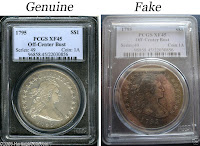 Even if you are buying graded coins that are encapsulated in a reputable third party grading service’s holder, you have to be careful with some coins because the slabs are now being counterfeited. The picture on the left was posted on the Collectors’ Universe Forums by user pcgs69 showing a genuine coin in a PCGS slab next to a counterfeit slab complete with valid serial number. In this case, pcgs69 knew the real coin was sold by Heritage Auction Galleries a few years earlier.
Even if you are buying graded coins that are encapsulated in a reputable third party grading service’s holder, you have to be careful with some coins because the slabs are now being counterfeited. The picture on the left was posted on the Collectors’ Universe Forums by user pcgs69 showing a genuine coin in a PCGS slab next to a counterfeit slab complete with valid serial number. In this case, pcgs69 knew the real coin was sold by Heritage Auction Galleries a few years earlier.
I was prompted to write about this from a friend who purposely bought a counterfeit Trade Dollar on a very well know online auction site. He knew it was counterfeit because it was dated 1886 (Trade Dollars were struck 1873-1885) but was curious as to what he would receive. The coin was sent from an address in China and arrived in ten days. The first thing he noticed was that the coin was made from a casting with softer details than a struck coins. My friend consulted a metallurgist who estimated the coin was made from a mixture of metals containing 40-percent silver. A real Trade Dollar is struck on a 90-percent silver planchet.
As my friend was telling me about the coin he asked if we will be seeing more of these coins this fall? With the Summer Olympics starting on 8/8/08 in Beijing, how many unsuspecting tourists will be sold counterfeits as “rare coins” and will try to post them on a popular online auction site hoping to make quick money?
Please be careful as you look to purchase items marked as “rare coins” from unfamiliar sources.
Apr 30, 2008 | counterfeit, currency
Local Washington, DC television news reported that counterfeit $20 and $100 bills have been found in circulation in Stafford County, Virginia, a suburb of Washington, DC. The Stafford County Sheriff’s office reports that the bogus notes have been passed at fast food restaurants and convenience stores. There are no suspects at this time.
 Counterfeiters are using $5 notes, bleaching them, and printing higher denominations over the paper. The notes may appear as washed out or very well used but has the security characteristic of the original $5 bill. The image to the right shows the watermark of a counterfeit note. Apparently, that is enough to prevent these notes from being accepted.
Counterfeiters are using $5 notes, bleaching them, and printing higher denominations over the paper. The notes may appear as washed out or very well used but has the security characteristic of the original $5 bill. The image to the right shows the watermark of a counterfeit note. Apparently, that is enough to prevent these notes from being accepted.
The sheriff recommends that the notes not be returned to the person who passed it, try to delay the person’s departure, ensure you can provide a physical description of the person and any companion, and call the sheriff’s office.
With all of the measures being added to notes by the Bureau of Engraving and Printing, and the publicity of those changes, especially here in the DC Metro area, it is unbelievable that counterfeiters can still get away with their crime. Apparently, the BEP must increase their education efforts in order to make this more effective.
One of BEP’s countermeasures against this type of counterfeiting are the new $5 bills. However, few have reported seeing these notes in circulation, even after the BEP and Federal Reserve said that only the new notes would be sent to the banks the first two weeks of release. I have yet to see one in circulation.
Image courtesy of the Stafford County Sheriff’s Office
Jan 7, 2008 | counterfeit, grading
Numismatic Guarantee Corporation (NGC) posted a message on its website (and in PDF) warning about counterfeit NGC slabs being on popular on line auctions sites from overseas. NGC’s message points out checking the serial number of the slab is not enough since the counterfeiter is matching the number with the coin information from NGC. There are subtle differences in the label that requires careful inspection rather than a passing glance.
Images of the fake NGC and ANACS slabs was posted by UtahCoin on the Collectors Universe forms then posted on the Collectors Society forums. It has been a hot discussion item since. It is important to note that only the old ANACS slabs were counterfeited, not the new Clearview holders.
No comment was made by ANACS. In fact, no news has come from ANACS since the official announcement of their sale to James Taylor.
UPDATED: As part of the announcement, NGC disclosed that they will be introducing a new holder sometime during 2008. The new holder will have new anti-counterfeiting mechanisms that addresses many of the issues found in this incident.
User braddick on the Collectors Society forums found images of a slab from a Chinese company resembling those used by the Professional Coin Grading Service (PCGS). It is speculated that it will be a matter of time before fake PCGS slabs are offered for sale.
Although it is not proper to stereotype, recent record of China-based sellers has demonstrated a great majority of rare, key, and semi-key date coins are either fake or significantly altered to look better to the detriment of their numismatic value. It highlights the axiom, “if it looks too good to be true, it probably is not true!”
Caveat emptor.
Mar 22, 2007 | counterfeit, dollar, errors, grading
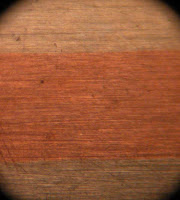 Numismatic Guarantee Corporation (NCG), published an article on their website warning about Washington Dollars with edges altered to resemble no-edge lettering errors. NGC said that “[less] than a month after their official release, Presidential $1 Coins with altered edges are being submitted to NGC for certification.” In the article, NGC provides detailed dimensions of the coins along with images of genuine and altered edges.
Numismatic Guarantee Corporation (NCG), published an article on their website warning about Washington Dollars with edges altered to resemble no-edge lettering errors. NGC said that “[less] than a month after their official release, Presidential $1 Coins with altered edges are being submitted to NGC for certification.” In the article, NGC provides detailed dimensions of the coins along with images of genuine and altered edges.
Collectors are urged to use the information to make informed decisions as to their purchase of these coins. Although it is popular to buy coins from online auction sites, collectors may want to ensure that the coins are certified from a reputable third party grading service. You may want to inquire as to the seller’s return policy should the coin be altered. Remember, a seven day return policy will not be enough time for a coin to be certified by most grading services. Here are some resources to learn more:
Image of altered Washington Dollar edge from NGC.
Mar 4, 2007 | counterfeit, currency, tokens
News reports out of New York City and Nassau County on Long Island reports that a 49 year old suspect has been passing bogus $50 and $100 bills in the area. Another suspect was arrested in Manhattan. Although suspects have been arrested, the New York Field Office of the US Secret Service is warning those in the metropolitan New York area that there may be more suspects and phony money in circulation. Secret Service has issued fliers showing the public what the fake bills look like.
- Click here to view the flier describing the counterfeit $100 bill
- Click here to view the flier describing the counterfeit $50 bill
In an unrelated story, a Buffalo man plead guilty to charges for his role in transmitting fake Toronto Transit Tokens into Canada. Tokens were made at an American token manufacturer and were to be sold in multiple shipments to Canadian dealers. These tokens have a face value of C$2.50. The real tokens were minted by the Royal Canadian Mint.
The Toronto Transit Commission (TTC) estimates that 40 percent of its tokens were counterfeit. To prevent further counterfeiting, TTC introduce a two-toned token and stopped accepting the old tokens on February 1.
 We start our look at the police blotter by reporting that FBI officials in New York reported that they arrested a Manhattan-based jeweler for allegedly robbing noted dealer Julian Leidman. Leidman estimated that 90-percent of his inventory has been recovered of an estimated $1 million worth of coins. Leidman’s car was broken into while he stopped at a restaurant in Montville, NJ on the way home from a show in Stamford, Connecticut.
We start our look at the police blotter by reporting that FBI officials in New York reported that they arrested a Manhattan-based jeweler for allegedly robbing noted dealer Julian Leidman. Leidman estimated that 90-percent of his inventory has been recovered of an estimated $1 million worth of coins. Leidman’s car was broken into while he stopped at a restaurant in Montville, NJ on the way home from a show in Stamford, Connecticut.






